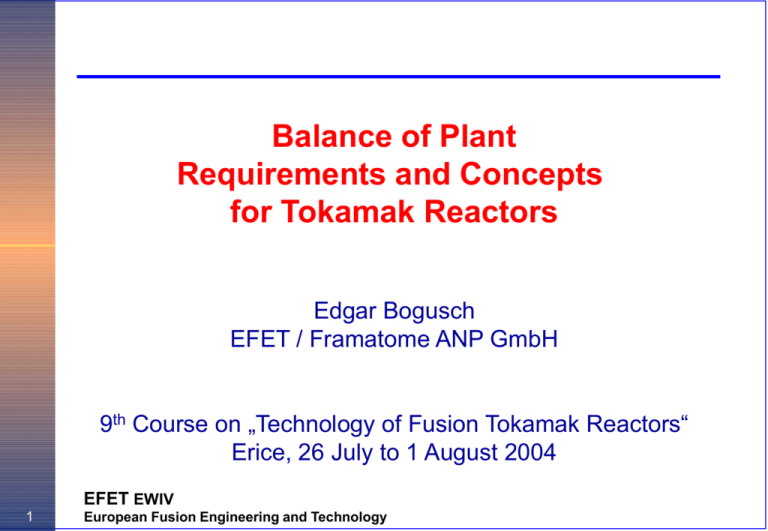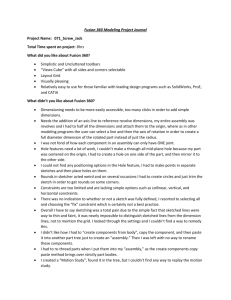Kein Folientitel
advertisement

Balance of Plant Requirements and Concepts for Tokamak Reactors Edgar Bogusch EFET / Framatome ANP GmbH 9th Course on „Technology of Fusion Tokamak Reactors“ Erice, 26 July to 1 August 2004 EFET EWIV 1 European Fusion Engineering and Technology Contents Introduction General Layout of Balance of Plant Requirements of BoP for Tokamak Reactors Conceptual BoP Layout for a Tokamak Reactor Reactor Models of PPCS Conclusions EFET EWIV 2 European Fusion Engineering and Technology Introduction A Power Plant can be divided into: The Steam Supply System (thermal heat source) Balance of Plant Systems (BoP) (systems for power conversion and distribution) EFET EWIV 3 European Fusion Engineering and Technology BoP Objectives Efficient conversion of thermal power to electricity Reliable electricity supply for its own components Minimum contribution to the overall plant costs High availability of systems and components Reliable and effective operation of auxiliary systems EFET EWIV 4 European Fusion Engineering and Technology References Designs of existing conventional and fission power plants SEAFP Studies Power Plant Conceptual Study (PPCS) EFET EWIV 5 European Fusion Engineering and Technology Objectives of the PPCS The Study has to demonstrate: The credibility of the power plant design(s) The claims for the safety and environmental advantages and for the economic viability of fusion power The robustness of the analyses and conclusions also relevant for the BoP Systems EFET EWIV 6 European Fusion Engineering and Technology Conventional Plants Boiler Heat transfer and conversion system incl. auxiliary systems EFET EWIV 7 European Fusion Engineering and Technology Schematic of a Combined Cycle Multi-Shaft Power Plant Heat recovery steam generator Gas turbine plant Steam turbine plant 9 Electrical energy Air Life steam Fuel Electrical energy 6 5 1 2 3 10 7 11 4 Exhaust gas 9 Gas turbine plant: Steam turbine plant: 1 2 3 4 7 8 9 10 11 12 Air intake Compressor Gas turbine Heat recovery steam generator 5 Generator 6 Transformer 8 Cooling tower Condensate 12 Steam turbine Condenser Feeding pump Generator Transformer Circulating pump Cooling air Fresh water EFET EWIV 8 European Fusion Engineering and Technology Fission Power Plants Nuclear Fission Plants Nuclear Steam Supply System (NSSS) (fission core, water/He/LM coolant) Heat transfer and conversion system incl. auxiliary systems EFET EWIV 9 European Fusion Engineering and Technology EPR Layout EFET EWIV 10 European Fusion Engineering and Technology Fusion Power Plants Nuclear Fusion Plants (Tokamak-Type) Tokamak core (fusion plasma) Confinement systems Plasma Heating systems Primary cooling system (water, helium, Pb - 17Li coolants) Heat transfer and conversion system incl. auxiliary systems EFET EWIV 11 European Fusion Engineering and Technology Important Systems and Components of the NSSS Reactor/tokamak core Reactor/vacuum vessel with all internals Primary loop (pumps, intermediate heat exchangers) DHR system Primary auxiliary systems Primary leak collection and leak detection systems Fire fighting systems for Primary Systems Core element handling Component handling Reactor protection system Reactor-specific instrumentation and control systems EFET EWIV 12 European Fusion Engineering and Technology Important Systems and Components of the BoP Buildings Steam and power conversion system Cooling water systems Auxiliary systems (e.g. auxiliary steam, hot water/cold water, demineralized water, compressed air) Ventilation systems Fire fighting systems for conventional fires Chemical water treatment Elevators and hoists Locks and gates Treatment of radioactive waste Plant and building drainage Systems for the electrical auxiliary power supply Non reactor-specific instrumentation and control systems EFET EWIV 13 European Fusion Engineering and Technology Strategy for a Fusion Power Plant To find a niche in the existing world of electricity producing power plants it is necessary to have: Competitive construction and electricity production costs Comparable availability The BoP systems have to provide a contribution to these requirements! EFET EWIV 14 European Fusion Engineering and Technology Requirements for Fusion Power Plants Base-load electricity production Steady-state operation Load-following capabilities Electrical power output equivalent to present LWR Easy maintenance Low recirculating power fraction EFET EWIV 15 European Fusion Engineering and Technology List of typical BoP Systems for a Tokamak Fusion Power Plant Secondary Heat Transport System Turbine Generator System Cooling Water Auxiliary Systems Water Treatment Plant Compressed Air System Fire Protection System Electric Power System HVAC System Vacuum Vessel Pressure Suppression System Other Auxiliary and Anxilary Systems EFET EWIV 16 European Fusion Engineering and Technology Heat Sources Present Power Plants: • Single heat source (boiler, fission core) Fusion Power Plants • Blanket and first wall • Divertor • Low temperature shield EFET EWIV 17 European Fusion Engineering and Technology BoP Systems with Specific Characteristics Relevant to a Tokamak Fusion Power Plant Primary Heat Transfer System Electric Power System HVAC System Vacuum Vessel Pressure Suppression System EFET EWIV 18 European Fusion Engineering and Technology Requirements for the BoP Low contribution to the construction costs (standard components, minimum number of safety relevant systems) High reliability and availability Scheduled downtimes to be included in the tokamak scheduled downtimes EFET EWIV 19 European Fusion Engineering and Technology Topics for Scheduled Maintenance Frequency depends on: Systems architecture (existence and number of redundancies) Lifetime of most significant equipment or components Maintenance duration mainly depends on: Scheduling of activities Design of most significant equipment Accessibility EFET EWIV 20 European Fusion Engineering and Technology Topics for Unscheduled Maintenance Frequency depend on: Systems architecture (existence and number of redundancies) Components reliability Human factor (training, procedures) Unscheduled maintenance duration mainly depends on: Design and accessibility of the less reliable components Testability Spare parts policy EFET EWIV 21 European Fusion Engineering and Technology PPCS Targets Plant availability > 80% Unscheduled availability < 7% Two years full power operation Four months shutdown EFET EWIV 22 European Fusion Engineering and Technology Availability and Reliability Gas Coal Fission Power Power Power Fusion Power Renew. Solar Hydro Wind Power Power Power Power Availability (1) 95.0 92.0 92.0 80.0 60.0 22.0 85.0 45.0 Reliability % (2) 92.0 90.0 90.0 88.0 94.0 95.0 95.0 92.0 Serviciability % (3) 87.0 83.0 83.0 66.0 56.0 21.0 81.0 41.0 Process efficiency (4) 0.60 (1) 0.50 (1) 0.36 0.40 0.52 0.2 0.92 0.85 Notes 1. Estimated figures. Availability: here only the planned maintenance is accounted for. 2. The reliability accounts for non planned outages. It has been taken smaller for the more complicated systems. The quoted figures are indicative and open to interpretation; however, if they should change by 3% the basic results would not be significantly impacted. 3. The serviciability is the product of (1) x (2). 4. The process efficiency is the thermomechanical efficiency for thermal plants and the hydraulic efficiency for hydro plants. EFET EWIV 23 European Fusion Engineering and Technology Comparison of PPCS Reactor Models Model A Model B Model C Model D Breeder Material Pb – 17 Li Li4 Si 04 Pb – 17 Li Pb – 17 Li Coolant Water Helium Helium Pb – 17 Li Thermal (Fusion) Power (MWth) 5,000 3,600 3,400 2,500 Electric Power Output (MWe) 1,500 1,500 1,500 1,500 Efficiency (%) 31 36 41 60 0.28 0.27 0.13 0.11 Recirculating Power Fraction EFET EWIV 24 European Fusion Engineering and Technology Power Conversion System Model A Primary heat in Primary heat out EFET EWIV 25 European Fusion Engineering and Technology Power Conversion System Model B EFET EWIV 26 European Fusion Engineering and Technology Heat Transfer System Model C Intercooler 1 Intercooler 2 Recuperator ~ Compressor 1 Compressor 2 Compressor 3 Turbine Heat Rejection HX EFET EWIV 27 European Fusion Engineering and Technology Generator Heat Transfer System Model D EFET EWIV 28 European Fusion Engineering and Technology Example of Hydrogen/electricity Production Scheme Generator PbLi Pump ELECTRICITY Blanket Coolant Circuit Steam Turbine Steam Generator f d h a e He Coolant c b g a: b: c: d: Blanket modules Divertor plates cold shield (permanent) vacuum vessel e: equatorial ports TOKAMAK REACTOR f: upper ports g: divertor ports h: TF coils Divertor Coolant Circuit EFET EWIV 29 European Fusion Engineering and Technology Heat Exchanger COGENERATION (STEAM/WATER) Similar PPCS technologies to Generation IV Fission Reactors Gas Cooled Fast Reactor system - relevant synergies with Model B He coolant, He loops and Turbomachinery technologies (490ºC-850ºC He temperature ranges) Very high - Temperature Reactor - relevant synergies with Model B and Model C High temperature, He loops and heat exchangers (1000ºC) for thermochemical H2 production. Supercritical - Water Cooled Reactor - Model A Model A may be further optimised for high pressure water cooled blankets and divertor operating above thermodynamic critical point of water (374ºC, 22.1 MPa). Lead Cooled Fast Reactor - Model C Material technology, heat transport, energy conversion and chemistry for lead (PbLi/PbBi) coolant systems. EFET EWIV 30 European Fusion Engineering and Technology Conclusions BoP systems play an important role for the reliable operation of a Fusion Power Plant. Heat transfer system and power supply have to meet specific characteristics of fusion power. The availability of the BoP has to compensate for the comparable low availability of the tokamak due to specific maintenance requirements. High efficient plant designs have been described in the PPCS but require future technologies still to be developed. EFET EWIV 31 European Fusion Engineering and Technology Conclusions cont. The availability factor is considered a key parameter in the Fusion Power Plant feasibility demonstration. Experience in Fission Plants shows that BoP availability is an important contribution to this parameter. EFET EWIV 32 European Fusion Engineering and Technology The Future EFET EWIV 33 European Fusion Engineering and Technology Source: FzK Acknowledgements I would like thank my colleagues of EFDA, Framatome ANP and Siemens Power Generation for their input to this presentation, and in particular Felix Alonso of IBERTEF/Empresarios Agrupados for his valuable comments and support. EFET EWIV 34 European Fusion Engineering and Technology Any questions? Please go ahead! EFET EWIV 35 European Fusion Engineering and Technology





